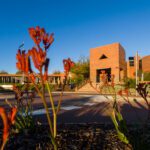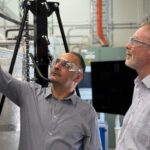Ten Curtin University research projects aimed at solving some of the country’s biggest challenges have secured more than $4 million in federal government funding in the latest Discovery Project round from the Australian Research Council (ARC).
The projects include exploring the link between wellness and the housing crisis, mining DNA data to help in the conservation of endangered species, how business can better serve diverse customers and the creation of new science to enable the development of low-cost, miniaturised electrochemical sensors.
Curtin University Deputy Vice-Chancellor Research Professor Melinda Fitzgerald congratulated the successful researchers.
“The ARC Discovery Projects scheme aims to support national and international research collaborations and enhance the scale and focus of Australian research,” Professor Fitzgerald said.
“This support from the Federal Government allows the advancement of significant Curtin research projects that have the potential to create lasting scientific, economic, sustainability and social benefits.”
Summaries of Curtin’s successful research projects are below:
Next-generation navigation by mega-constellations LEO satellites (led by Professor Ahmed El-Mowafy): This research will explore a novel positioning approach using new mega-constellations low-earth-orbit satellite communications signals to address a severe limitation of Global Navigation Satellite Systems (GNSS). It will facilitate improved positioning for services that rely on satellite positioning in challenging environments where GNSS signal visibility is limited, and where accurate positioning is needed. Expected outcomes are generating new knowledge in using satellite internet signals for navigation, advancing our satellite positioning capability essential for vital applications such as transport, mining and defence, and developing technologies to increase Australia’s satellite innovation capacity with global scalability.
eGenomics – Next generation biomonitoring of threatened species (led by Professor Morten Allentoft): DNA is the molecule of life and exists everywhere in the environment as a largely untapped source of information on evolution, biodiversity, and ecosystem health. Our overriding aim is to start mining that information to benefit threatened species. Based on optimized ancient DNA methods, powerful sequencing technology, whole genome analyses, and RNA profiling, we present a novel and holistic framework for genetic biomonitoring. In two parallel model systems we will study corals and reptiles to improve environmental detection while simultaneously obtaining information on their population health. This will foster more efficient conservation of endangered species that are of tremendous importance to our marine and terrestrial ecosystems.
Precarious housing, housing assistance and wellbeing (led by Professor Rachel Ong ViforJ): Australia’s housing system is undergoing a major transformation, marked by growing precariousness that has now spread across all housing tenures. The wellbeing impacts of this are not well-understood. This project aims to develop a contemporary conceptualisation of housing precariousness as a multidimensional experience that exists in potentially variable ways for renters, owners and the marginally housed. Using mixed methods and cross-country analyses, the project expects to produce new evidence on pathways in and out of precariousness, as well as the coping strategies and wellbeing of the precariously housed. This is expected to offer major benefits by informing housing assistance policies that promote the wellbeing of Australians.
Living Together: New approaches to multispecies conflict and coexistence (led by Associate Professor Robert Briggs): Building on the methods and concepts of the emerging environmental humanities, this project will produce a new conceptual vocabulary for a world in which multispecies conflict and coexistence is increasingly important. It brings critical and generative re-readings of classical political thought and contemporary biopolitical and cosmopolitical approaches into dialogue with a set of empirical case studies emerging from novel encounters between humans and other animals. This project will expand Australia’s knowledge base and research capacity in the interdisciplinary environmental humanities and stake out new approaches to the question of living together in a changing environment.
Investigating energy transfer pathways in lanthanoid elements (led by Professor Massimiliano Massi): This project aims to investigate fundamental aspects concerning the luminescent properties of compounds containing lanthanoid elements. These elements have extensive use in many high-tech applications, yet essential knowledge related to their properties is still quite limited. This project will elucidate in detail the origin of lanthanoid luminescence through a multidisciplinary approach combining synthetic chemistry and spectroscopy. The outcomes of this proposal will expand our limited knowledge in this field, underpinning the future development of novel materials for advanced applications. This will lead to significant economic benefit in Australia as new commercial applications relying on lanthanoid luminescence will be developed.
Unlocking the potential of poly(ionic liquids) for electrochemical sensing (led by Professor Debbie Silvester): This project aims to create new science that will enable the development of low-cost, miniaturised electrochemical sensors based on poly-ionic liquids. The chemistry of the materials will be tuned to selectively detect hazardous pollutants to enable trace concentration detection at analytically relevant levels. Fundamental behaviour of gases and solid contaminants dissolved in poly-ionic liquid/ionic liquid membranes will be uncovered, and their performance for sensing in real environments will be examined. It is expected that these advances will transform detection methods by taking sensing out of the lab and into the hands of the everyday person, giving rapid and accurate knowledge about the concentration of hazards in the environment.
Optimising benefits of cultural diversity in Australian healthcare sector (a jointly-led multidisciplinary project with four team members: Professor Piyush Sharma, Dr Russel Kingshott, Associate Professor Amy Tian, and Chair Professor Julia Backmann, University of Muenster, Germany): Australian society and workplaces are increasingly becoming culturally diverse with growing numbers of immigrants from culturally and linguistically diverse (CaLD) backgrounds. However, it is not clear to what extent this diversity is being harnessed to improve organisational performance by leveraging the diverse range of knowledge and skills of CaLD customers and employees. This project aims to use social identity theory and role theory to develop a comprehensive conceptual model for the process by which organisations identify, acknowledge, engage, accept, and adapt to cultural and linguistic diversity among their customers and employees. We also plan to test this model with data from customers and employees in Australian service sector.
Electron-molecule collisions in fusion and astrophysical plasmas (led by Professor Igor Bray): This project will apply innovative methods developed in Australia to accurately model electron collisions with diatomic hydrides. It will generate new knowledge of the dynamics underlying fundamental chemical reactions and bring international scientists together to study the influence of molecules in plasmas more accurately than ever before. Outcomes will include essential diagnostics for fusion reactors, methods for using the James Webb Space Telescope to study astrophysical clouds and strengthened ties between Australia and the global plasma physics community. The significant benefits will include accelerating the development of fusion technology as an alternative to fossil fuels and furthering our understanding of stellar evolution.
Diversifying audio description in the Australian digital landscape (led by Professor Kathleen Ellis): Audio description (AD) is a track of narration describing important visual elements of visual media to make it accessible to people who are blind or vision impaired. It is also increasingly being used by the mainstream audience. This project aims to examine the consumption and production of Audio Description throughout Australian cultural life. It expects to generate new knowledge about the ways digital media including emerging generative artificial intelligence might be leveraged to increase access to audio description. Expected outcomes include a curriculum, guidelines and materials designed to empower industries, communities and governments to work together to meet Australia’s obligation to provide access to cultural activities using AD.
Ion-atom collision data for fusion energy, hadron therapy and astrophysics (led by Professor Alisher Kadyrov): This project aims to combine experimental and theoretical efforts to generate accurate data required for the development and maintenance of fusion reactors, treatment planning in hadron therapy of cancerous tumours, and modelling astrophysical phenomena. Hadron therapy has been used successfully worldwide for over a decade with Australia’s first such facility, the Bragg Centre for Proton Therapy, currently under construction. Fusion reactors are a source of abundant green energy. Immense progress is being made in their construction and underlying technology. Currently, there is an urgent demand for accurate data on ion-beam collisions with atoms and molecules for the aforementioned applications. This project intends to meet this demand.
For more on the ARC Discovery Scheme visit here.



